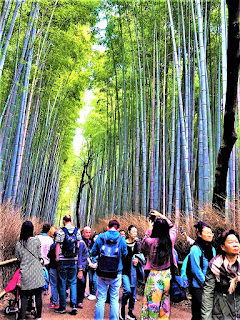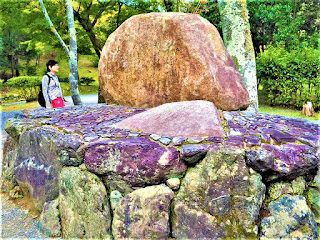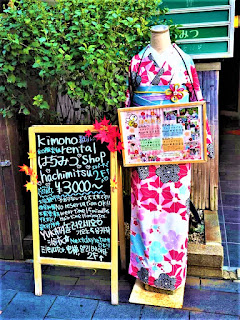2018 怀古在京都 (1) - 时代祭
10月22日我们开始日本京都双人自助行。“京都”的前名是“平安”,从794 到1869 是日本朝廷的国都。所以漫游京都是怀古。京都的人口约一百五十万。
早上参观了“二条城”,1603年建的军阀殿宇,一个联合国教科文组织世界遗产。也在一个艺术和手工艺品博物馆停留了一阵子,里面不可拍照,只偷拍到几张扇。
京都一年一度的怀古游行“时代祭”刚好今天举行,我们三生有幸,可以见证这个盛典。有两千人参与游行,队伍长达两公里。游行者穿不同朝代的衣着,最后出现的是两顶龙辇,皇帝的轿子,代表京都的第一任和最后一任的日本天皇,第七场照片所示的是其中一顶。游行终点是平安神宮,有个巨型鸟居,在日本神道中,鸟居代表神域的入口,区分神栖息的神域和人类居住的世俗界。
2018 Roaming historic Kyoto (1) - Jidai Matsuri
Kyoto, formerly known as "Heian", was the old capital of the Japanese imperial court from 794 to 1869. It has a population of about 1.5 million. We started our self-planned 2-person tour on 22nd October after the Hokkaido group tour.
Morning visited the Nijo Castle, built in 1603 as the residence of a shogun. A UNESCO World Heritage Site. Then had a look at an arts and crafts museum. No photography allowed, just steal a shot of some Japanese fans.
"Jidai Matsuri" is the yearly parade to celebrate the history of Kyoto. We are lucky to be here today to witness the yearly event. 2,000 people are said to be involved, 2 km long, clothed in various costumes reflecting the history of the city. Near the end of the parade are 2 palanquins, called "mikoshi" which contain the spirits of the 1st and the last emperors based in Kyoto. The 7th photo shows one of them. The parade ended at the Heian Temple with a huge torii at the approach. A torii is a traditional Japanese gate found at the entrance of a Shinto shrine, where it symbolically marks the transition from the mundane to the sacred.
2018 怀古在京都 (2) - 大阪
今天的天气预报说京都会下雨,我们避重就轻,去了六十公里外的大阪,大阪的人口约两百七十万。老天的脸整天阴沉沉,偶尔掉几滴泪。没有艳丽照片分享。
先看大阪城,1583 年建成,五层的主塔 1997 年重修。五层塔上拍到这条龙头鱼身的祥物。
再去看了两间著名的旧庙。第一间是座佛庙 Shitennoji,593年建,自夸是日本最旧的佛庙。第二间是座神社,Sumiyoshi Taisha,三世纪建立,建筑设计有本土特色。这间是两千多间Sumiyoshi庙中的主庙。
傍晚去一个购物区Shinsekai 或“新世界”。这区一百年前是顶尖的商城,现已沦为二等公民,餐厅居多。大型餐厅广告争艳。
2018 Roaming historic Kyoto (2) - diversion to Osaka
Kyoto was projected to be raining today, so we went to Osaka instead, a city about 60 km away, with a population of 2.7 million. It was cloudy and gloomy the whole day with light drizzle on and off. Not good for photography.
First visited the Osaka Castle, built in 1583. The main tower is 5 story high, last renovated in 1997. Shown also a fish with a dragon head found on the roof.
Then 2 old temples. First the Shitennoji Buddhist temple, first built in 593. Claimed to be the oldest in Japan. Then the Sumiyoshi Taisha, established in the 3rd century. It is one of the oldest Shinto shrine in Japan and the mother shrine of over 2,000 such Sumiyoshi shrines. The entrance is under a gable, said to be a pure Japanese architecture.
In the early evening, went to the shopping area called Shinsekai or New World. Developed about 100 years ago it has lost much of its shine. It is now famous as a eating place. Plenty of giant advertisements on eateries.
2018 怀古在京都 (3) - 嵐山
嵐山是京都西郊的旅游景区。两个著名的景点(各两张照)是天龙寺和竹林。天龙寺是京都五大禅寺之首,一个联合国教科文组织世界遗产。竹林是一条两百米长的小径,万人空巷,大塞人。
其他较特出的景点有(1)周恩来记念石,周总理在1917年曾来嵐山一游,(2)一间小神社,Nonomiya,妇女在此求缘求孕,(3)一间大别墅,Okochi Sanso Villa,我们在花园走了半小时,(4)一间九世纪创立的佛庙,Adashino Nenbutsuji,其独特处是院子里有千多个大小不一的小石墩,超度孤魂。
2018 Roaming historic Kyoto (3) - Arashiyama
Arashiyama is a western suburb of Kyoto, a touristic district. The 2 major attractions (2 photos each) are the Tenryuji and the Bamboo Glove. The Tenryuji is the 1st of the 5 major Zen temples in Kyoto, a UNESCO World Heritage Site. The Bamboo Glove is a 200 m long narrow path in the bamboo forest. Human traffic jam.
Other notable sights are (1) Zhou En Lai Memorial, Premier Zhou visited Arashiyama in 1917, (2) the small Nonomiya Shrine where women pray for marriage and conception, (3) the Okochi Sanso Villa with a huge garden where we walked for half an hour, (4) the 9th century Adashimo Nenbutsuji Temple. There are over a thousand stone statues in the courtyard, with different designs, each representing a dead.
2018 怀古在京都 (4A) - 伏见稻荷大神社
天气预报说今天是大晴天,我们去看伏见的稻荷大神社,最上镜景点,多贴照片。
稻荷是日本神道的稻神,全国有数千所稻荷社,以伏见的为总社。第二张照是神社的主要庙宇。这里吸睛点是那橙红色鸟居,数以千计,非常壮观。鸟居都是个人或商家或团体所捐赠,捐赠者的名字刻在的鸟居后部,第五张照片。狐狸是稻荷神的使者,口銜谷仓的钥匙。最后的照片所示的是一束束的千只纸鹤,信徒为许愿而折。
2018 Roaming historic Kyoto (4A) - Fushimi Inari Shrine
Today is a sunny day so we visited the photogenic Fushimi Inari Shrine and post more photos.
Inari is the Shinto god of rice. The shrine at Fushimi is the most important of several thousands of Inari shrines. The 2nd photo shows the main shrines. The main attractions are the brightly coloured torii gates, thousand of them. The gates are donated, details of the donors given at the back of the pole, 5th photo. The fox is the messenger of Inari, and it holds the key to the rice barn. The last photo shows origami cranes, in batches of a thousand, presented as votive offerings.
2018 怀古在京都 (4B) - 东山区
今天也去了东山区,看几个景点。最有名的是清水寺,八世纪始创的佛庙,一个联合国教科文组织世界遗产。可惜主殿正在重修,没照可拍,两张照片所示的是前厅的塔和主殿下的水泉。
也买票入门看了另一座佛庙,高台寺,示其日本式花园。路过一间神社,八坂神社,和另一处五层高的八坂神塔,也在丹山公园停留一阵子。
东山区也是著名看和服的地方。这里的女人有穿和服的习惯。花枝招展,艳丽迷人。当然还有不少外国游客穿着租来的和服鱼目混珠。
2018 Roaming historic Kyoto (4B) - Higashiyama
Also went to the Higashiyama area. The main attraction is the Kiyomizu-dera Temple, established in the 8th century and a UNESCO World Heritage Site. The main hall is under renovation. Shown a pagoda and people collecting "sacred" water at the base of the main hall.
Visited also another temple, Kodai-ji Temple, showing the Japanese garden. Passed by Yasaka Shrine and Yasaka Pagoda (different places) and also the Maruyama-keon Park.
Higashiyama is also famous for meeting women in kimono. But some are really foreigners on rented kimono trying to be cool.
2018 怀古在京都 (5) - 三间佛庙 + 祇园
今天参观了三间佛庙,都是联合国教科文组织世界遗产。也都是大型的寺庙,建筑物从多,庭园广大。每间两张照片。
第一间是金阁寺,十四世纪初建。主殿三层高,最高两层外墙贴满了金箔,金光闪闪,阁前的湖景也迷人。第二间是龙安寺,有个闻名的庭园,是日本庭园抽象美的代表作:在一片矩形的粗粒白沙地上,分布着五组长着青苔的岩石。第三间是仁和寺,创于九世纪。示一座五层古塔和一尊门神像。
其他时间在祇园溜荡。祇园是以前艺妓献艺的旧区,茶屋,餐厅,卖纪念品的小店。还有租和服的。
2018 Roaming historic Kyoto (5) - 3 temples+ Gion
Earlier went to 3 big temple complexes, all of them UNESCO World Heritage sites. 2 photos for each temple.
The 1st is Kinkakuji Temple founded in the 13th century. The top 2 floors of the 3-storied main hall are gold-leaf coated externally. With a beautiful garden too. The 2nd is Ryoanji Temple with the most famous rock garden in the country. It has 14 pieces of rocks arranged in 5 groups placed on top of white coarse sand in a rectangular field. The 3rd is Ninnaji Temple, founded in the 9th century. Shown the very old 5-tier pagoda and the statue of a guardian warrior.
Later we roamed around Gion, a district where formerly the geisha plied their trades. Tea houses, restaurants, souvenir shops and shops renting kimonos by the hour.
2018 怀古在京都 (6) - 祇园
早上又在祇园游荡,跟着部落客M Lambe 推荐的路线走走停停看看拍拍。
第一张照片所示的是京都僅有的日本歌剧院。第二是一尊Jizo菩萨的雕像,八百年前菩萨在一场天灾中救人无数。第三是一张艺妓表演的广告海报。第四是一间著名茶馆,三百年前武士们在此叹茶讲数。第五是嵌入路面的吸睛路牌。第六是建仁寺的一座古茶碑。第七是一条运河畔的丰姿,闹中带静。
下午在京都大车站旁的Aeon Mall花钱。这间大百货中心可名不符实,名为Aeon Mall, Aeon 可没有分店在此。
2018 Roaming historic Kyoto (6) - Gion
Morning in Gion again, walked the route suggested by blogger M Lambe. First at the Minamira Kabuki Theater, the opera house for the traditional "kabuki" dance-drama. Then the small Meyami Jizo Shrine to honour the guardian saint Jizo, established in 1228. An advertisement poster for a geisha performance. Next the old tea house of Ichiriki Chaya, a meeting place of samurais 300 years ago. The 5th photo shows a cute road sign embedded on the pavement. Next is a very old stone stela honouring tea art at the Kenninji Temple and lastly a scenic shot along the idyllic Shirakawa Canal.
Afternoon shopping at the big Aeon Mall near the Kyoto train station. But strangely no sighting of any Aeon outlet here, despite the name of the mall.
2018 怀古在京都 (7) - 大结局
十月二十八日是我们京都七日游的最后一天。今天也是礼拜天,早上去一间天主教主教座堂听日语的彌撒。圣堂建于1967年,有四百四十个座位,今早的彌撒有八成满。
然后去新京极商店街走走,这里专卖较奇特的东西。这些T恤衫印有奇奇怪怪的标语,每件标价数百令吉。再到比邻的锦市场看看,吃海鲜午餐,这三串扇贝/乌贼花五十令吉。
最后介绍一间我们天天看到的佛堂,東本願寺,它就在我们住的旅店附近。它是日本佛教的一个宗系的两座主堂的其中一座,创建於1602年。照片所示的是它的一个礼仪门楼,那2.65迷高的钟是2010年铸造,取代那1602年的旧钟。
傍晚回家咯,游记也结束。拜拜,后会有期。
2018 Roaming historic Kyoto (7) - closing chapter
28 October is our last day in Kyoto. A Sunday too. Morning went to the St Francis Xavier Cathedral to attend a Sunday mass said in Japanese. The church was built in 1967, with seating for 440. Today's mass about 80% full.
Followed by a visit to the covered shopping arcade called Shinkyogoku, famous for tacky and funny souvenirs. Here they sell niche T-shirts with all kind of wordings, and each cost several hundreds of Ringgit. We then walked to the Nishiki Market for seafood lunch. The 3 sticks of scallops/squids cost RM 50.
Lastly introduce the temple we passed by everyday. It is the Higashi Honganji, established in 1602 and joint head temple of a sub sect of Shin Buddhism. It is located very near to our hotel. Shown the elaborate Founder's Hall Gate. The giant bell, 2.65 m high, was newly installed in 2010, to replace the old one dated to 1602.
Will fly home in the evening. The story is ended. Bye bye See you the next time.
































































No comments:
Post a Comment